7 Species of Woodpeckers in Indiana (With Pictures)
Last Updated on
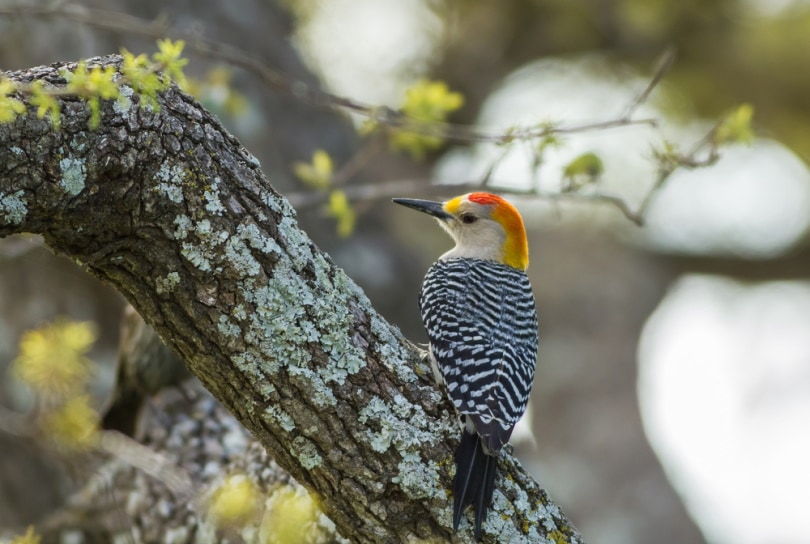
Woodpeckers are remarkable birds that belong to the Picidae family. What makes them unique is their ability to bore through tree bark to look for insects and build nests. There are about 180 species of woodpeckers, and they can be found in nearly all parts of the world, except for Australia and New Guinea.
Indiana is home to several different woodpecker species. Here are some of the most common woodpeckers that take up residence in this state.

The 7 Species of Woodpeckers in Indiana
1. Downy Woodpecker
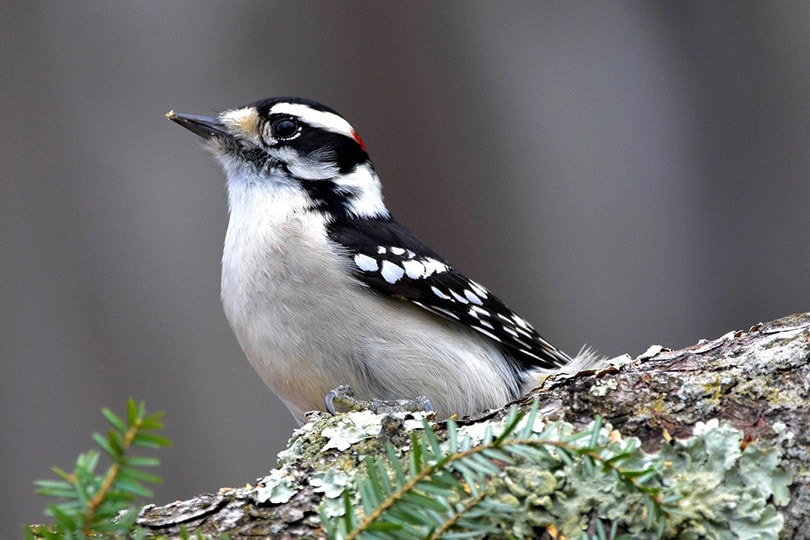
| Scientific Name: | Picoides pubecens |
| Color: | Red, black, white |
| Length: | 5-7 inches |
| Wingspan: | 9-12 inches |
The Downy Woodpecker is a common bird that you can find in densely wooded places, such as forests and orchards. You can also find them in some suburban areas, especially parks, throughout Indiana. Many people have had success attracting them to their yards by using suet feeders.
This woodpecker is the smallest of woodpeckers inhabiting North America. You can identify it by its tiny streak of red on its crest and striped markings on its face.
2. Hairy Woodpecker
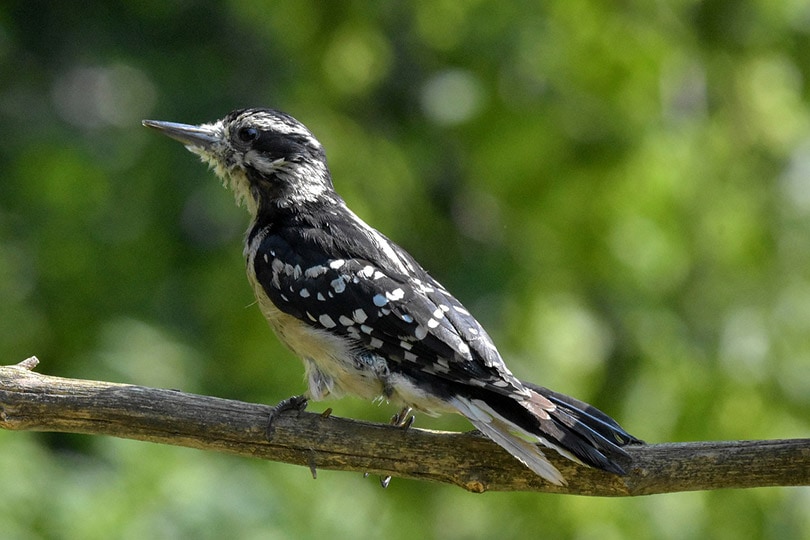
| Scientific Name: | Picoides villosus |
| Color: | Red, black, white |
| Length: | 7-10 inches |
| Wingspan: | 13-17 inches |
From far away, the Hairy Woodpecker can look very similar to the Downy Woodpecker. However, this species is larger and has a longer bill. They’re also an adaptable and common species of woodpeckers and can be found in forests as well as suburban neighborhoods.
Hairy Woodpeckers mostly eat insects that live in trees, such as ants, bark beetles, and moth pupae. They can also eat some seeds and fruit, so you can have some luck inviting them into your backyard with a bird feeder.
3. Northern Flicker
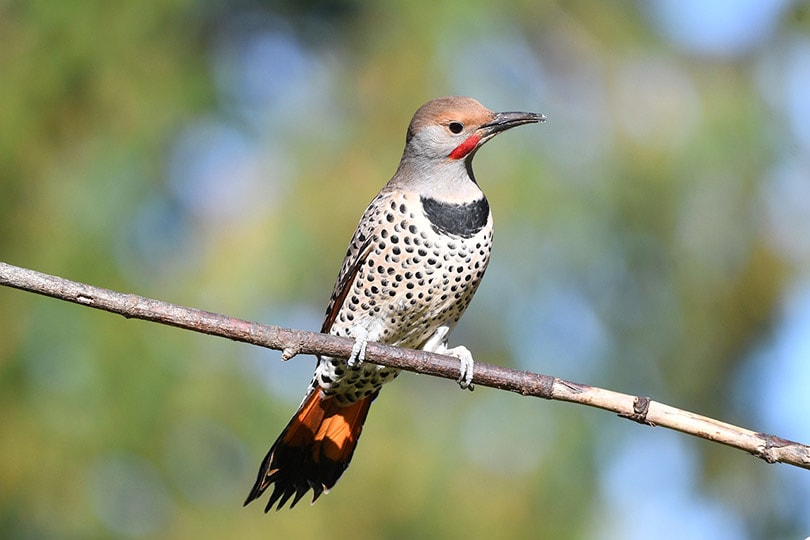
| Scientific Name: | Colaptes auratus |
| Color: | Red, black, white, gray |
| Length: | 12-13 inches |
| Wingspan: | 20-22 inches |
The Northern Flicker shares the checker patterned feathers that many other woodpecker species have on their breasts and wings. However, they don’t look like the stereotypical woodpecker. These birds aren’t black and white with flashes of red. Rather, they have tan and gray feathers and a relatively round head.
Northern Flickers prefer to be on the ground foraging for insects and some fruits and seeds. When they’re up on trees, they’d rather perch on horizontal branches rather than rest against tree trunks.
4. Pileated Woodpecker

| Scientific Name: | Dryocopus pileatus |
| Color: | Red, black, white |
| Length: | 16-20 inches |
| Wingspan: | 30 inches |
The Pileated Woodpecker bears the image that most people envision when they think of woodpeckers. The famous Woody the Woodpecker was inspired by the males of this species, which have a large, vibrant red crest.
Pileated Woodpeckers prefer to nest in large trees. Their bills are so strong that they can snap small trees in half while searching for insects. Your best chances of seeing this bird would be in the southern half of Indiana.
5. Red-Bellied Woodpecker
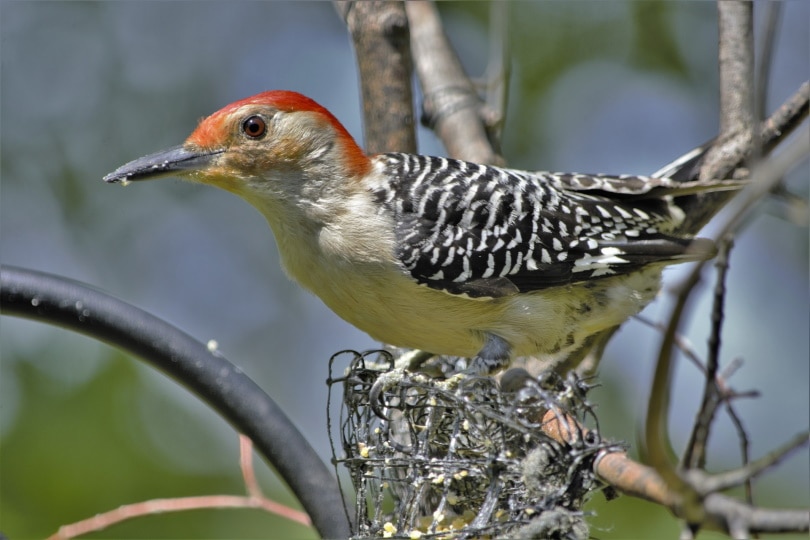
| Scientific Name: | Melanerpes carolinus |
| Color: | Red, black, white |
| Length: | 9-11 inches |
| Wingspan: | 15-18 inches |
Red-Bellied Woodpeckers are smaller woodpeckers that have red feathers that start on their crest and run down their neck. They have pale bellies and black and white-striped feathers.
These birds prefer to perch on medium and large trees. They mostly eat nuts and seeds and some fruit. While they’ve been spotted all over Indiana, you’ll have the most luck spotting them in the southern parts of the state.
6. Red-Headed Woodpecker
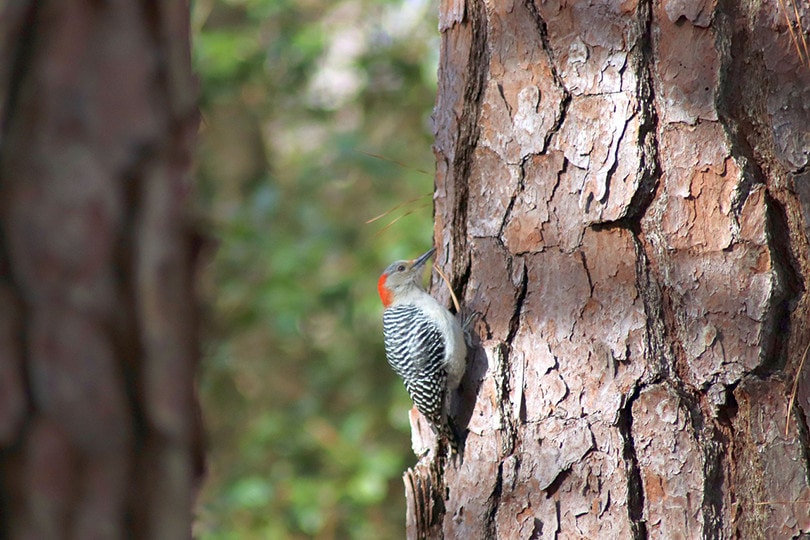
| Scientific Name: | Melanerpes erythrocephalus |
| Color: | Red, black, white |
| Length: | 7-10 inches |
| Wingspan: | 16-17 inches |
The Red-Headed Woodpecker is known for the blocks of colors on its body. These woodpeckers have a completely red head, a black back, and white breast. Their wings have blocks of black and white with black tips.
These woodpeckers like to rap on trees to catch insects and can also eat fruit and seeds. They have a shrill and scratchy call and are often found in forests, pine savannas, and wetlands.
7. Yellow-Bellied Sapsucker

| Scientific Name: | Sphyrapicus varius |
| Color: | Red, black, white |
| Length: | 7-8 inches |
| Wingspan: | 13-16 inches |
Yellow-Bellied Sapsuckers have red feathers on their foreheads and the front of their necks. Some will have yellowish bellies, while others can have white bellies. They like to perch on trees and drill holes to drink the sap. They can also eat some insects.
These woodpeckers prefer living in conifer forests and open woodlands. However, if food is scarce, they’ve been known to visit bird feeders for suet. The best way to find them is to look for sap wells on trees that are neatly lined in a row.
How To Attract Woodpeckers to Your Yard

Although woodpeckers can cause damage to some trees, there are some benefits to having woodpeckers in your yard. Many woodpeckers are insectivores and enjoy eating common garden pests, such as wood-eating larvae, termites, beetles, and caterpillars.
Since woodpeckers mostly prefer roosting and inhabiting dead trees, you don’t have to worry so much about them severely hurting growing trees in your yard. So, if you’re interested in attracting them to your yard, you can try several things to encourage them to visit.
The first thing you’ll want to do is lay out some snacks that are enticing to these birds. While woodpeckers are insectivores, they also can enjoy sap, peanuts, sunflower seeds, and acorns. One of the most effective ways to attract woodpeckers is to use a suet feeder so that woodpeckers can enjoy a variety of foods.
Another method you can try is posting an upright bird feeder that’s specifically designed for woodpeckers. These types of feeders will have a solid base that woodpeckers can grip with both their feet and tail feathers. They feel more natural for woodpeckers and can encourage them to eat the food inside the feeder.
Lastly, if you don’t have any particular issues with insect infestations, leave the deadwood on your trees. Woodpeckers like to poke through dead trees to find insects, so they’ll enjoy excavating through deadwood for food.
Conclusion
Woodpeckers live all throughout Indiana. If you know what to look for, where to look, and what to listen for, there’s a really good chance that you can find them. Since they’re not the largest of birds, you’ll probably hear them before you see them, and you might need a pair of binoculars to locate them. These birds play an important role in ecosystems, so we’re sure they’ll appreciate the recognition from a respectful distance.
You might be interested:
Featured Image Credit: Warren Price Photography, Shutterstock
About the Author Robert Sparks
Robert’s obsession with all things optical started early in life, when his optician father would bring home prototypes for Robert to play with. Nowadays, Robert is dedicated to helping others find the right optics for their needs. His hobbies include astronomy, astrophysics, and model building. Originally from Newark, NJ, he resides in Santa Fe, New Mexico, where the nighttime skies are filled with glittering stars.
Related Articles:
Monocular vs Telescope: Differences Explained (With Pictures)
10 Types of Hummingbirds in Arkansas (With Pictures)
8 Types of Hummingbirds in Nebraska (With Pictures)
5 Types of Hummingbirds in Idaho (With Pictures)
3 Types of Hummingbirds in Mississippi (With Pictures)
8 Types of Hummingbirds in Kansas (With Pictures)
5 Types of Hummingbirds in West Virginia (With Pictures)
5 Types of Hummingbirds in Ohio (With Pictures)
